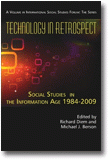
Technology in Retrospect
Social Studies in the Information Age, 1984-2009
Edited by:
Richard A. Diem, University of Texas - San Antonio
Michael J. Berson, University of South Florida
A volume in the series: International Social Studies Forum: The Series. Editor(s): Cathy A. R. Brant, Rowan University.
Published 2010
January 2009 marked the 25th anniversary of one of the most famous three minutes of television history. It was during half-time of the 1984 Super Bowl that APPLE show cased its new Macintosh Computer in an avant-guard commercial. In the following three weeks sales of the new computer, in both the public and private sectors, took off leading some to note this occasion as the "true" start of the information age. At the same time schools joined this so-called information revolution and began to use the new technology, in various forms, in a much more serious manner.
Given both the changing nature of technology, as well as its classroom applications, over the past quarter century this work's goal is to capture the historical trends of both use and application of information technology in the social studies during this era. This is done by providing a retrospective view , from 1984 through 2009 , of where we've been, where we are, and a view of new tools and strategies and possible studies that are emerging that can enhance our understanding of the effects that technology has and will have on the social studies.
CONTENTS
As It Was—1984, Richard A. Diem. In the Beginning, Apple: Ways in Which the Vision Progressed, Cheryl A. Franklin Torrez. Young Learners: Constructing Social Studies with Technology, Linda Bennett. The Internet in Social Studies Classrooms: Lost Opportunity or Unexplored Frontier? Adam Friedman and Phillip J. VanFossen. Digital History and the Emergence of Digital Historical Literacies, John Lee. From Personal Pastime to Curricular Resource: The Case of Digital Documentaries in the Social Studies, Meghan McGlinn Manfra and Thomas C. Hammond. Where We’ve Been; Where We Are; Where We’re Going: Geospatial Technologies and Social Studies, Marsha Alibrandi, Andrew Milson, and Eui-kyung Shin. Framing Children as Citizens: A Journey from the Real World to Digital Spaces, Ilene R. Berson. Wired to Act: Black Youth’s Civic Engagement and Technology Use in 21st Century Elections, Patrice Preston-Grimes. An Examination of Technology Use in Middle School Social Studies Classrooms During the 2008 U.S. Presidential Election Cycle: A Case Study, June Byng. High School Utilization of Technology as a Source of Information for the 2008 U.S. Presidential Election: A Case Study, Vanessa Hammler Kenon. Consumers or Producers of Democracy: Moving Civic Education from the Information to the Empowerment Age, Joe O’Brien. Globally Connected Social Studies: Making it Real, Making it Relevant, Tim Dove, Jeff Elliott, Merry Merryfield, and Betsy Sidor. Media Convergence and the Social Studies, Jeremy Stoddard. Social and Cultural Implications of Technology Integration in Social Studies Education, Cheryl Mason Bolick. Social Studies and Technology 2009-2034, David Valdez, B. Justin Reich, and Michael J. Berson. About the Authors.
-
Paperback978-1-61735-038-2
Web price: $45.04 (Reg. 52.99)
-
Hardcover978-1-61735-039-9
Web price: $80.74 (Reg. 94.99)
- eBook9781617350405

-
 Best Practices in Social Studies Assessment
Best Practices in Social Studies Assessment
-
 Democracy's Discontent and Civic Learning
Multiple Perspectives
Democracy's Discontent and Civic Learning
Multiple Perspectives
-
 It’s Being Done in Social Studies
Race, Class, Gender and Sexuality in the Pre/K-12 Curriculum
It’s Being Done in Social Studies
Race, Class, Gender and Sexuality in the Pre/K-12 Curriculum
-
 Machines
Machines
-
 Mending Walls
Historical, Socio‐Political, Economic, and Geographical Perspectives
Mending Walls
Historical, Socio‐Political, Economic, and Geographical Perspectives
-
 Sustainability, Growth, and Globalization
A Social Science Perspective
Sustainability, Growth, and Globalization
A Social Science Perspective
-
 The Status of Social Studies
Views from the Field
The Status of Social Studies
Views from the Field

